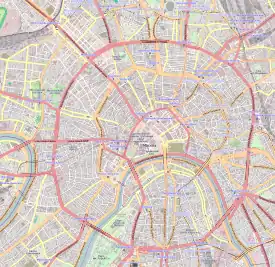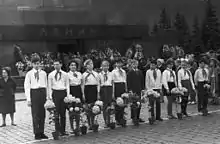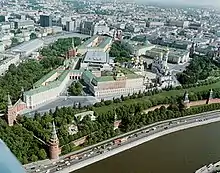Lenin's Mausoleum
Lenin's Mausoleum (from 1953 to 1961 Lenin's & Stalin's Mausoleum) (Russian: Мавзолей Ленина, tr. Mavzoley Lenina, IPA: [məvzɐˈlʲej ˈlʲenʲɪnə]), also known as Lenin's Tomb, situated on Red Square in the centre of Moscow, is a mausoleum that serves as the resting place of Soviet leader Vladimir Lenin. His preserved body has been on public display there since shortly after his death in 1924, with rare exceptions in wartime. Alexey Shchusev's diminutive but monumental granite structure incorporates some elements from ancient mausoleums, such as the Step Pyramid, the Tomb of Cyrus the Great and, to some degree, the Temple of the Inscriptions.
| Мавзолей Ленина Mavzoley Lenina | |
.jpeg.webp) Lenin's Mausoleum, 2006 | |
 Location in Central Moscow | |
| Coordinates | 55°45′13″N 37°37′11″E |
|---|---|
| Location | Moscow, Russia |
| Designer | Alexey Shchusev |
| Type | Memorial |
| Material | Concrete and marble |
| Completion date | November 10, 1930 |
| Dedicated to | Vladimir Lenin Joseph Stalin (formerly) |
History


Lenin died on 21 January 1924. Two days later, architect Alexey Shchusev was tasked with building a structure suitable for viewing of the body by mourners. A wooden tomb, in Red Square by the Moscow Kremlin Wall, was ready on January 27, and later that day Lenin's coffin was placed in it. More than 100,000 people visited the tomb in the next six weeks.[1] By August 1924, Shchusev had replaced the tomb with a larger one, and Lenin's body was transferred to a sarcophagus designed by architect Konstantin Melnikov.
Pathologist Alexei Ivanovich Abrikosov had embalmed Lenin's body shortly after his death, but by 1929 it was determined that it would be possible to preserve the body for much longer than usual; therefore, the next year a new mausoleum of marble, porphyry, granite, and labradorite (by Alexey Shchusev, I.A. Frantsuz and G.K. Yakovlev) was completed. The mausoleum also served as a viewing stand for Soviet leaders to review parades on Red Square.
In 1973, sculptor Nikolai Tomsky designed a new sarcophagus.
On January 26, 1984, the Head of the Moscow Garrison issued an order to place the guard of honour at the mausoleum. Russians call it the "Number One Sentry". After the events of the Russian constitutional crisis of 1993, the guard of honour was disbanded. In 1997, the "Number One Sentry" was restored at the Tomb of the Unknown Soldier in Alexander Garden.
Lenin's body was removed in October 1941 and evacuated to Tyumen, in Siberia, when it appeared that Moscow might be in danger of capture by German troops. After the war, it was returned and the tomb reopened.
More than 10 million people visited Lenin's tomb between 1924 and 1972.
Joseph Stalin's embalmed body shared a spot next to Lenin's, from the time of his death in March 1953 until October 1961, when Stalin was removed as part of de-Stalinization and Khrushchev's Thaw, and buried in the Kremlin Wall Necropolis outside the walls of the Kremlin.
Lenin's body was to have been transferred to the Pantheon upon its completion but the project was cancelled in the aftermath of de-Stalinization.
Preserving the body

One of the main problems the embalmers faced was the appearance of dark spots on the skin, especially on the face and hands. They managed to solve the problem by the use of a variety of different reagents. For example, if a patch of wrinkling or discoloration occurred it was treated with a solution of acetic acid and ethyl alcohol diluted with water. Hydrogen peroxide could be used to restore the tissues' original colouring. Damp spots were removed by means of disinfectants such as quinine or phenol.[2]
Until the fall of the Soviet Union in 1991, the continued preservation work was funded by the Soviet government. At that point the government discontinued financial support and private donations then supported the preservation staff.[3] In 2016 the Russian government reversed its earlier decision and said it planned to spend 13 million rubles to preserve the body.[4]
Lenin's Mausoleum today


_01.jpg.webp)
The Mausoleum is open to the public on Tuesdays, Wednesdays, Thursdays, and Saturdays from 10:00–13:00.[5] Visitors still queue to see Lenin's body although queues are not as long as they once were. Entrance is free of charge. Before visitors are allowed to enter the mausoleum, armed police or military guards search them. Visitors are required to show respect whilst inside the tomb: photography and filming inside the mausoleum are forbidden, as is talking, smoking, keeping hands in pockets, or wearing hats (unless female).[6]
Since 1991, there has been some discussion about removing Lenin's body to the Kremlin Wall Necropolis and burying it there. President Boris Yeltsin, with the support of the Russian Orthodox Church, intended to close the tomb and bury Lenin next to his mother, Maria Alexandrovna Ulyanova, at the Volkov Cemetery in St. Petersburg. His successor, Vladimir Putin, opposed this, pointing out that a reburial of Lenin would imply that generations of citizens had observed false values during seventy years of Soviet rule.[7]
The mausoleum has undergone several changes in appearance since the collapse of the Soviet Union. One of the first noticeable changes was the placement of gates at the staircases leading to the central tribune. After the removal of the guard, this was necessary to prevent unauthorised usage of the tribune. Beginning in 2012, the mausoleum underwent foundation reconstruction caused by the construction of a building attached to the mausoleum in 1983. The building houses an escalator once used by members of the politburo to ascend the tribune. In 1995–96, when Boris Yeltsin used the tribune, he used stairs and not the escalator. Now the tribune is no longer used, therefore it became acceptable to remove the escalator. The building was closed in 2013 for renovations. It was finally opened on April 30, 2013 in time for the May 1 celebration of "The Day of Spring and Labour". In 2018 RIA Novosti reported that Vladimir Petrov, member of the legislative assembly of the Leningrad Oblast, proposed to create a special commission in order to examine the question of Lenin's body removal from the Mausoleum. Petrov seemed to be willing to replace the corpse with a copy made of synthetic resin. The deputy Dimitry Novikov, member of the communist party, has strongly declared himself against Petrov's proposition.[8]
Honours
- The Hungarian People's Republic issued a postage stamp depicting it on 20 February 1952.
- The Soviet Union issued postage stamps depicting it in 1925, 1934, 1944, 1946, 1947, 1948, and 1949.
See also
- Kumsusan Palace of the Sun
- Ho Chi Minh Mausoleum
- Kremlin Wall Necropolis
- Lenin's Memorial Museum in Moscow
- Lenin's Museum in Ulyanovsk
- Lenin's Museum in Gorki Leninskiye
- Tampere Lenin Museum
- Joseph Stalin Museum, Gori
- Mausoleum of Mao Zedong
- Pyramid of Tirana
- House of Flowers
- Pantheon, Moscow
- Sun Yat-sen Mausoleum
- Chiang Kai-shek Memorial Hall
- Che Guevara Mausoleum
- Santa Ifigenia Cemetery
- El Museo Histórico Militar de Caracas
- Sükhbaatar's Mausoleum
- Georgi Dimitrov Mausoleum
- National Monument in Vitkov
- Carol Park
- Mustafa Kemal Atatürk's Mausoleum
- Mausoleum of Ruhollah Khomeini
- Raj Ghat
- Mazar-e-Quaid
- Bourguiba mausoleum
- Türkmenbaşy Ruhy Mosque
- Washington's Tomb (United States Capitol) (unused)
- Artigas Mausoleum
- Martyrs' Mausoleum, Yangon
References
- Gwendolyn Leick (15 November 2013). Tombs of the Great Leaders: A Contemporary Guide. Reaktion Books. p. 39. ISBN 978-1-78023-226-3.
- Zbarsky, Ilya; Hutchinson, Samuel (1999). Lenin's Embalmers. Harvill Press. p. 215. ISBN 1-86046-515-3.
- Mark McDonald (1 March 2004). "Lenin Undergoes Extreme Makeover". Associated Press. Retrieved 19 April 2010. (alternative url Archived 2010-07-04 at the Wayback Machine)
- "На сохранение тела Ленина в 2016 году истратят более 13 млн рублей". 2016-04-12.
- "Visiting the Diamond Fund, the Grand Kremlin Palace and Lenin's Mausoleum". www.kreml.ru. Retrieved 2020-06-28.
- "Расписание работы Мавзолея В.И. Ленина" [Opening hours of the Mausoleum of V.I. Lenin] (in Russian). Federal Protective Service (Russia). Archived from the original on 2019-04-23. Retrieved 2017-12-06.
- See, e.g., a statement by President Putin in Sankt-Peterburgsky Vedomosty, July 19, 2001.
- "Депутат предложил заменить тело Ленина в Мавзолее копией". 2018-11-14.
